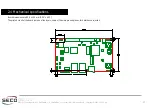
SBC-C23
SBC-C23 User Manual - Rev. First Edition: 1.0 - Last Edition: 1.1 - Author: S.B. - Reviewed by L.B. -Copyright © 2020 SECO S.p.A.
23
3.3.2
USB ports
The i.MX6 SoloX processor offers two USB 2.0 OTG interfaces
The first USB OTG port is carried out to a standard micro-AB connector, described in the table on the left.
Depending on the needed use of the system, it is necessary to connect micro-A or micro-B USB
cables to connector J2.
A micro-A USB cable has to be used when the system has to work in Host mode. In this case,
USB_VBUS is a power output of SBC-C23 Board for the connected device.
When a micro-B USB cable is used, its USB_ID pin is floating; this way, the board acknowledges that it must configure
itself to work as a Client. In this case, USB_VBUS is an input of the carrier board from the external Host.
Signal description of this port:
U/USB_OTG1-: USB OTG Port #1 differential pair.
USB_OTG1_VBUS: USB voltage rail. It is an input for USB port working in Client mode, an output for Host mode.
USB_ID: Client/Host identification signal. This signal is high when the USB port works in client mode, is low when works in Host mode. NVCC_3V0 electrical level
with a 47K
Ω
pull-up resistor
The second USB OTG port is used The USB HSIC interface is carried to a Microchip USB2514 USB 2.0 Hub, which makes available four further USB 2.0 Host
ports .
One of them is carried out to a standard type-A connector, described in the table on the left.
Signal description of this port:
/USB_DS4-: USB Hub Downstream Port #4 differential pair.
USB_OTG2_VBUS: USB voltage rail, output supply voltage for USB client devices connected to this port.
Common mode chokes are placed on all USB differential pairs for EMI compliance. For ESD protection, on all data and voltage lines are placed clamping diodes for
voltage transient suppression.
Micro-AB USB connector - J2
Pin Signal
1
USB_OTG1_VBUS
2
USB_OTG1-
3
U
4
USB_ID
5
GND
USB Host port connector - J3
Pin Signal
1
USB_OTG2_VBUS
2
USB_DS4-
3
4
GND






























